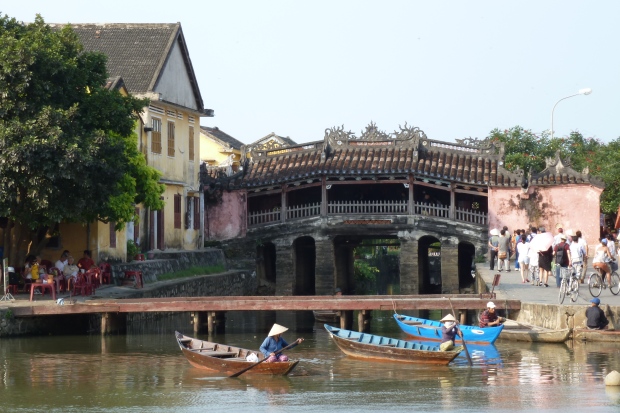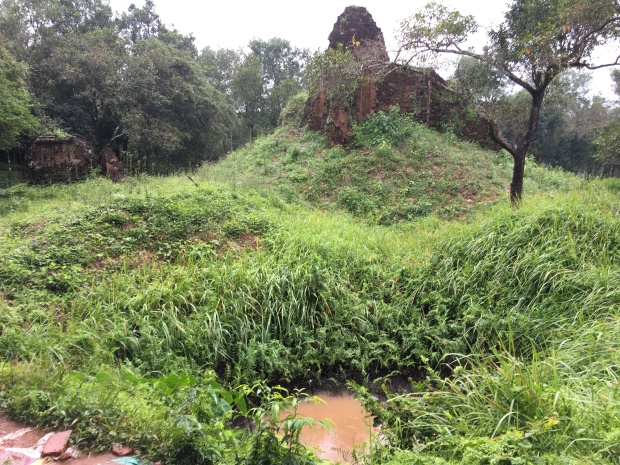Our last stop in Vietnam was Ho Chi Minh City. The city was known as Saigon for many years until it was renamed after the end of the Vietnam War. Interestingly, locals still often refer to it as Saigon. This is Vietnam’s largest city with about 10 million inhabitants.

View of central Ho Chi Minh City. The central tower has an observation deck for tourists.
The first thing we noticed on our drive into the city from the airport was how different it felt from Hanoi! Ho Chi Minh City felt much more vibrant, fashionable and modern – with lots of marquee international stores and young people on scooters going everywhere.

View of Ho Chi Minh City from the observation deck mentioned above.
We spent two days here. Our first day was spent exploring the sights in the core downtown area (on foot) and on our second day we took a day trip to the Cu Chi Tunnels, about 70 km (45 miles) outside the city.
War Remnants Museum
This is the main tourist attraction in Ho Chi Minh City. It tells the story of the Vietnam War from the perspective of the Vietnamese people and their Communist regimes.

Exterior view of the War Remnants Museum.

The courtyard of the War Remnants Museum is filled with various U.S. Military equipment.
Of course, horrific tragedies occurred on both sides and no one was innocent in this conflict. The whole war was an unfortunate disaster that caused pain and suffering on both sides.

A sign post in the War Remnants Museum.

Prisoner cages.

This map shows the areas of heaviest fighting during the Vietnam War (areas in black).

A display inside the War Remnants Museum.
The museum is large and well organized, with exhibits on several floors and outside the main building. Plan at least two hours for your visit, and if you want to read everything, even longer.
Jade Emperor Pagoda
This temple takes the cake for weirdness for those of us less initiated in the Buddhist and Taoist religions – with crowded, smoke (incense) filled rooms.

Exterior of the Jade Emperor Pagoda

Exterior detail at the Jade Emperor Pagoda.
It’s hard to describe, although Lonely Planet does a pretty good job: “this is one of the most spectacularly atmospheric temples in Ho Chi Minh City, stuffed with statues of phantasmal divinities and grotesque heroes”.

Interior view of Jade Emperor Pagoda with a variety of figures.

Another view in the Jade Emperor Pagoda.

One other view of the interior of the Jade Emperor Pagoda.
The temple is not old, having been constructed in 1909 in honor of the supreme Taoist god (known as the Jade Emperor), Ngoc Hoang. It is crowded with strange-looking figures and jumbled rooms. Definitely worth a visit!
Notre-Dame Cathedral Basilica of Saigon
This basilica was built between 1863-1880 by the French during the period of French colonialism in Vietnam. One of the vestiges of their occupation is this beautiful (and out of place) cathedral located in the heart of the city on a pretty square.

A view of the Basilica in Ho Chi Minh City. The statue of Mary in the foreground supposedly shed tears in 2005, stopping traffic in this busy area.
All of the materials for this cathedral were imported from France.

Interior view of the Basilica.
Central Post Office
Right next to the Cathedral is another relic of the French era, the Central Post Office. This building was constructed in the late 1800’s and contains two beautiful paintings on its walls (maps of Saigon and the larger region) and a variety of shops.

Exterior view of the Central Post Office.

Interior view of the Central Post Office.
There is a tourist office here where we arranged for our tour of the Cu Chi Tunnels (see below).
Cu Chi Tunnels
These relics of the Vietnam War are less than 45 miles outside the city, but took about 90 minutes to reach due to traffic getting out of the city. They are well worth the effort. We did this as part of a day tour (our group had about eight people).

Entrance to the Cu Chi Tunnels.
The extensive tunnel systems served as communication and transportation networks to aid the Viet Cong in fighting the South Vietnamese and U.S. forces. There are two main tunnel areas that can be visited: Ben Duoc and Ben Dinh, our tour went to Ben Dinh.

A main entrance into one of the bunkers at Cu Chi Tunnels.
Some rooms were large enough to be used as conference rooms and hospitals.

One of the war rooms in the Cu Chi Tunnels.

Hospital display at the Cu Chi Tunnels.
There are 250 km (155 miles) of tunnels here, some are two levels deep. It must have been quite an engineering feat to dig these tunnels and lay out the system in a stealth manner.
We were shown secret entrances, disguised air vents, and treacherous booby traps. We had the opportunity to crawl on our hands and knees through tiny tunnels that had lovely bats flying around you!

A hidden entrance to the tunnels.

A typical corridor in the tunnels.

Cramped space in the Cu Chi Tunnels!

Concealed air shaft to the tunnels.

Booby trap – watch your step or you could end up falling on these huge spikes.
Be sure to wear clothes you don’t mind getting dirty! After spending time crawling on our hands and knees in the tunnels in a damp humid climate we gained an appreciation for what it must have been like to live in these conditions for months or years.
Ho Chi Minh City is a great place to visit, be sure it’s on your itinerary in Vietnam.



























































